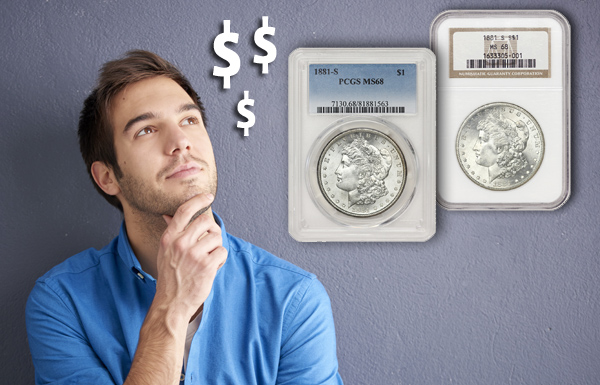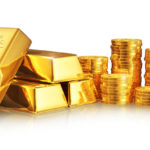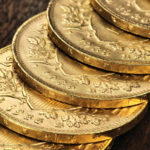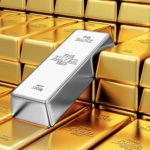Why Do Coins of the Same Grade Have Different Prices?
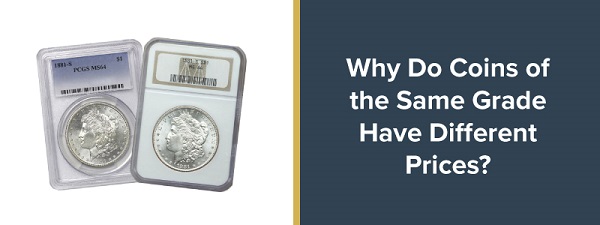
This is an excellent question. It shows that the investor is genuinely trying to learn about the coin industry and wants to make wise investments. It’s also an important question because the answer can teach you so a lot about coins. Below are the six most common reasons why two exact coins, with the same grade, could sell for different prices.
1. Who Is Selling the Coins?
Clients will sometimes see two coins listed online. The two coins are exactly the same coin, although a different seller is selling each one. And the two coins are completely different prices. So where does this discrepancy come from?
Different sellers have different opinions on how much a coin is worth. There have been countless times when I’ve seen the same exact coin offered by two different sellers, and the prices can vary by as little as $100 or as much as $10,000.
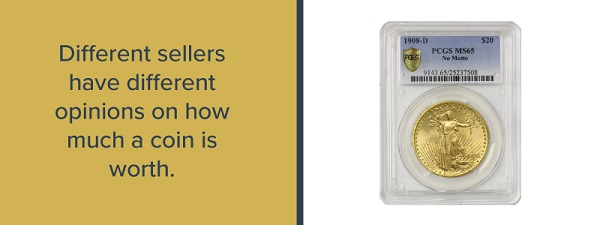
The most common reason for a seller to ask for more is that they are just refusing to lower their price and accept anything less than what they’re asking. But of course, there can be other reasons as well. Other factors might include a required profit margin, purchase cost, length of ownership, love of the coin, lack of product knowledge, and so on.
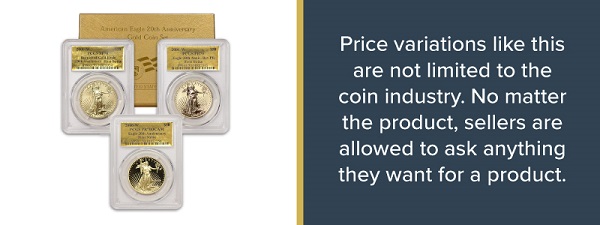
Price variations like this are not limited to the coin industry. No matter the product, sellers are allowed to ask anything they want for a product. Whether or not anyone will pay that price is a different story, but they are certainly allowed to ask for it.
To illustrate, imagine there are three identical houses, all right next door to one another. The owner of the House #1 decides to sell their house for $150,000. Seeing this, the owners of Houses #2 and #3 also decide to list their homes for sale, but for different prices. Owner #2 decides to list their home at $150,000 and Owner #3 lists theirs at $250,000.
All three owners most likely have completely valid personal reasons for their asking prices and should be free to name whatever asking price they choose. However, the buyer is also free to pay this asking price or to move on until they find a different house with an asking price that better suits them.
Most likely they will find a knowledgeable real estate agent who will educate them about factors like market competition and recent previous sales. The agent will also make sure there are no issues with the property and protect the buyer from any potential issues that may arise. A reputable agent will help the buyer determine which, if any, of these houses are the best value for the buyer’s money.
In this way, a reputable, knowledgeable coin dealer is just as essential as the real estate agent in this scenario. Like a knowledgeable Real Estate Agent when buying a home, a reputable, educated coin dealer is imperative when considering buying coins.
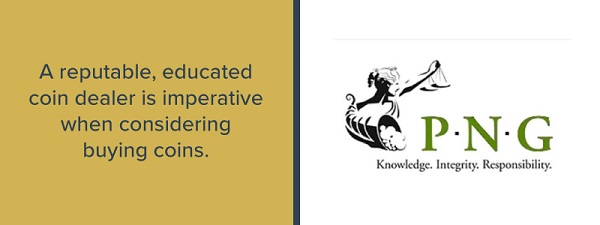
2. What Are the Label Details?
Occasionally two coins with the same grade may appear to be identical when in reality, they aren’t. If you come across two coins that seem to be identical, but that are listed for different prices, carefully check the fine print of the grading labels.
There are a couple of things to look for in the grading labels. Check to be sure the two coins have the same date, mint, grade, grading service, and special attributes. If you look carefully, you may notice small differences in these details. These variances may seem relatively insignificant, but they can quickly multiply to make a large difference in the price of a coin.
For example, one coin may have a rather common date, while another may have an extremely rare date. Other common attributes, such as error coins, can drastically raise or lower coin values.
3. How Much Eye Appeal Do the Coins Have?
This is one of the most important and most often overlooked aspects of a coin’s price. Put simply, the question here is, “How pretty is the coin?”
In coin collecting and investing, appearance matters. You might take two coins with a very similar grade and hold them next to one another. They might be of an almost equal grade, but their appearance can differ vastly. As you look at the two coins, ask yourself., In what ways do they look different? Do they look the same, or does one look nicer than the other? Is one more lustrous than the other?
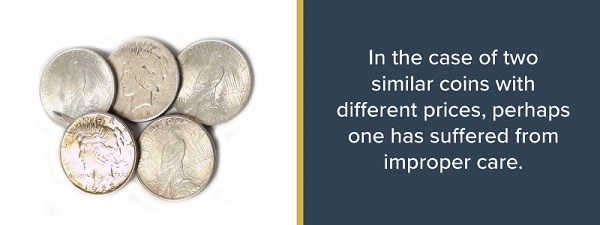
Unfortunately, a coin’s condition can deteriorate over time if its owner hasn’t taken proper care of it. In the case of two similar coins with different prices, perhaps one has suffered from improper care. Maybe one coin has a sharper strike or more definition than the other. Or perhaps there was a minting error during the manufacturing process that caused cracks, spots or unevenness. While such mint errors may not necessarily affect the grade of a coin, they will most definitely affect the coin’s appearance, and thus, its price.
These are just some of the issues that can make identically graded coins look very different. In the numismatic industry, this is referred to as Sight Seen coins vs. Sight Unseen coins. This terminology is an elaborate way to say that Sight Seen coins are usually much prettier and have much more eye appeal than Sight Unseen coins.
Even though it might seem less important than other facets of a coin, this simple matter of eye appeal is one of the primary reasons for the significant price variations of seemingly similar coins.
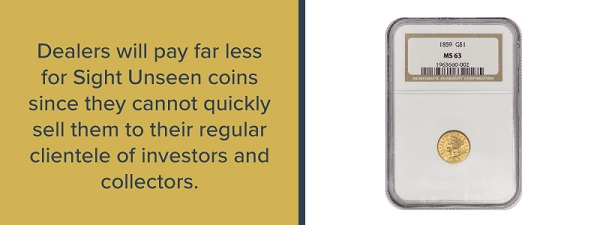
Why Is “Pretty” So Important?
There’s another important reason that appearance matters. In the future, if you ever want to attempt to sell your coin, a more visually appealing coin will almost always sell for more money. And there’s an easy answer for why this is the case. People like pretty, eye-catching things.
The next collector or investor who buys your coin is going to want to own a coin they’ll be proud to show off to their friends and family. That means they’re going to be willing to pay more for it. Dealers will also pay more, knowing the coin will be much easier to sell.
The simple fact is that prettier coins just sell faster. This point is summarized in the chart below.

In this example, it’s easy to see how many people might think that Coin 2 would be a much better value than Coin 1. After all, the selling price is lower. But because of factors such as eye appeal, which directly affects the future sales potential, the Sight Seen coin, Coin 1, is actually the better value.
A dealer buying back the Sight Seen coin (Coin 1) is comfortable paying a slightly higher price for it. Dealers know that a Sight Seen coin will be snatched up almost immediately by an educated, long-term regular coin buyer that will be eager to own such a visually appealing coin. The dealer also knows that the Sight Unseen coin will sit in the dealer’s inventory much longer and won’t bring in as high a sale price as the much prettier Sight Seen coin.
An experienced dealer will be able to distinguish between Sight Seen and Sight Unseen coins and can advise their clients accordingly. Because of this, we always recommend you consult with an experienced and well-respected dealer. They will help you be sure that you’re buying the right coins for you.
4. Who Graded the Coins?
Another possible explanation for the price discrepancy between two equally graded coins could be found in the grading service itself. This grading service is an essential part of the value of any coin.
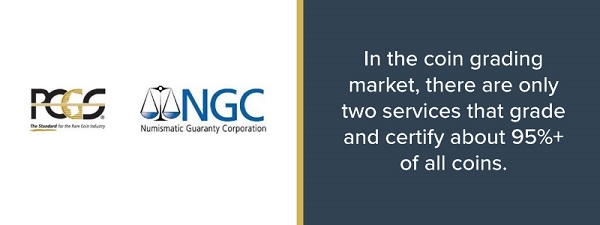
In the coin grading market, there are only two services that grade and certify about 95%+ of all coins. Those two services are the Professional Coin Grading Service (PCGS) and the Numismatic Guaranty Corporation (NGC). Both services are well established and highly respected in the numismatic industry. They both do an excellent job of coin grading, as well as performing verification of two other crucial criteria for numismatic coins. They certify that the coin is authentic and not counterfeit and that it has not been artificially enhanced. Since originality is so critical in coins, this verification process is essential.
Together, these three components determine a coin’s grade and value. Both PCGS and NGC put their money behind their certifications. Both companies guarantee that if, at any time, one of their coins is revealed to be fake, altered in some way or over-graded, they will buy back the coin at the original market value they graded it at.
That being said, smaller grading companies do exist that will sell ‘similar’ coins for less money. This is because these smaller companies typically grade coins at much higher grades than what PCGS or NGC would grade them. This inflates the value of these coins beyond what it would be if they had been graded by PCGS or NGC. Because of this, we always recommend only buying coins that were graded by certified coin graders such as PCGS or NGC.
5. Are There Any Extra Rarities or Bonuses?
Over the past 30 years, the major grading services have done an excellent job of finding additional ways to label coins that have something ‘extra’ about them. Some examples of these ‘extras’ include First Strikes, Early Releases, PL, Hoards, Pedigree, and Mint/Die Errors. There are so many other ‘extras’ that it would be impossible to include them all here.
There are also additional 3rd party services, such as PQ Approved and CAC, that have created their own coin stickers. A sticker from one of these service lets you know the company believes the stickered coin is among the finer examples in that grade from that mintage.
The problem is that it can be difficult to determine whether these stickers and extras actually do anything to increase the value of a coin in the future. Some of these bonuses can certainly make for a good conversation starter or can add to the overall impressiveness of the coin.
Unfortunately, conversation and impressiveness don’t actually hold any tangible value. Many of these bonuses often turn out to be little more than excuses to raise the asking price of a coin without adding any real value.
To learn more about these stickers and extras, we recommend you speak to an experienced coin dealer. They will be able to help you distinguish between coins that are real rarities and others that just have a neat feature.
6. Does the Deal Seem Too Good to Be True?
This last reason is something that’s important and applicable in almost every area of our lives, not just in the coin industry. More often than not, buying any product or service involves some level of risk. If you’ve done your research and find someone offering a deal that seems too good to be true, it just might be. This philosophy also applies to coins.
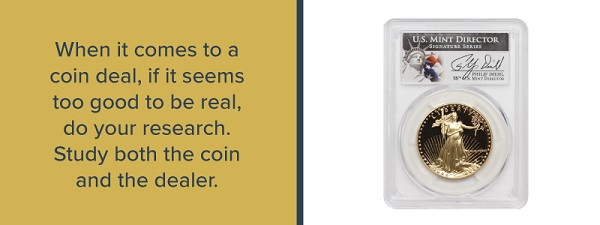
I can’t stress enough how important this is. When it comes to a coin deal, if it seems too good to be real, do your research. Study both the coin and the dealer. Are they members of any of the major Dealer Organizations such as the PNG? If they’re on eBay, check their feedback, how frequently and recently they’ve changed their eBay user id, their return policy and the length of time they’ve been selling, which may be different than how long they’ve been an eBay member.
Be extremely thorough in your research and don’t be afraid to ask the necessary questions. If the dealer is legitimate, they won’t mind answering them.
It’s also important to be aware of the sales venue, including if and how they vet their sellers. I’ve had numerous people tell me they bought a rare coin priced over $10,000 at a flea market for $1,000 and are then surprised when I tell them the coin is counterfeit. If a deal is too good to be true, and the person is rushing you to complete the transaction, don’t buy the coin. Stop, think about it and take the time to ask an expert.

Every so often, a legitimate deal really is that good. But those cases are few and far between. If it seems like a deal that’s too good to be true, it’s probably a scam. Again, this is why it’s always best to work with a reputable dealer. Too often, dishonest dealers just want to make a quick buck, and then they hope never to see you again. Honest, reputable dealers want you to have an enjoyable experience, and will always hope to work with you in the future.
BONUS - How Do You Keep Learning From Good Dealers?
In this article, I’ve touched on some very key points and mentioned multiple times the importance of working with good, experienced, well-respected dealers. To assist you with your continued education, I’m going to give you a few ways to find that person you want to work with.
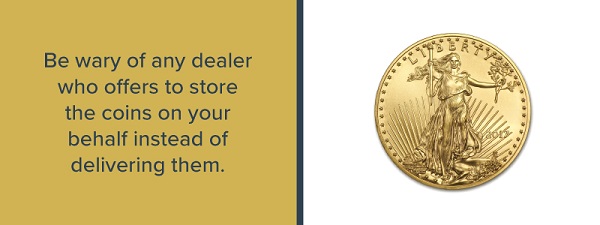
- See if they are a PNG Dealer by visiting https://pngdealers.org/. The PNG is so well respected that even eBay features their dealers and gives them monthly featured coin auctions. PNG Dealers are located mostly across the US and are a network of full-time dealers that can only be voted in by the current members. This means that they’re not only well respected by other dealers, but they also have good ethics. As a PNG Dealer, they must also verify that they have a financial background. They must agree to participate in binding arbitration with any client they dispute with, which will be reviewed by other highly experienced dealers.
- Be cautious of any dealers you see who heavily advertise or have commissioned sales reps or account executives. Keep in mind that any company that pays for expensive advertising will likely charge more to cover their expenses and commissions. Always ask the company how much they will repurchase a coin for and do your own online research to determine who this dealer is and if they’re reputable.
- Be wary of any dealer who offers to store the coins on your behalf instead of delivering them. Most reputable coin dealers offer delivery on the majority of their inventory as soon as payment clears. They will gladly ship to you. Some might offer additional storage options, but it is purely voluntary. It’s always a good idea to get your coins delivered, especially if you have no relationship with the dealer. It’s also best to beware of any dealer that claims to offer a cheaper deal but needs two or three months to deliver it.
- When you’re investigating any dealer, see what other additional things they have done to contribute to the industry. This extra step is an excellent way to see if they are well-respected and admired by fellow dealers. Do they head or participate in organizations for the industry? Do they teach classes? Have they been honored with awards by the community, and so on? All these things help show if the dealer you want to work with knows what they are doing and is really here to help you.
If you’re looking to buy coins, please browse our selection of coins and bullion available online. We offer free shipping on our wide range of products. No matter what it is you’re looking for, you’re likely to find something here to help build or diversify your collection. You might even find that rare coin you’ve been searching for to fill a hole in your collection; and if not, contact us and we can usually find it for you. If you have coins you’re looking to sell, we can do that, too.
If you have any questions about anything discussed here, such as how to research coin dealers online to learn whether or not they are legitimate and ethical, call us anytime at 1-888-454-0444. We’re happy to answer your questions about numismatic products and dealers, your investing and collecting goals and interests, or anything else.


